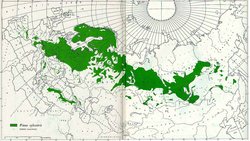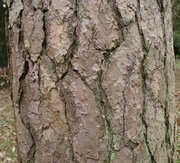Scots Pine
|
|
| Scots Pine | ||||||||||||||||
|---|---|---|---|---|---|---|---|---|---|---|---|---|---|---|---|---|
| Missing image Pinus_sylvestris1.jpg Mature Scots Pines in native forest, Mar Lodge, Deeside, Scotland | ||||||||||||||||
| Scientific classification | ||||||||||||||||
|
The Scots Pine (Pinus sylvestris; family Pinaceae) is a common tree ranging from Great Britain and Spain east to eastern Siberia and the Caucasus Mountains, and as far north as Lapland. In the north of its range, it occurs from sea level to 1000 m, while in the south of its range, it is a high altitude mountain tree, growing at 1200-2500 m altitude.
In the British Isles it is now native only in Scotland, but historical records indicate that it also occurred in Ireland, Wales and England as well until about 300-400 years ago, becoming extinct here due to over-exploitation; it has been re-introduced in these regions. Similar historical extinction and re-introduction applies to Denmark and the Netherlands.
It grows up to 35 m in height when mature, exceptionally 40 m. The bark is thick, scaly dark grey-brown on the lower trunk, and thin, flaky and orange on the upper trunk and branches. The habit of the mature tree is distinctive due to its long, bare and straight trunk topped by a rounded or flat-topped mass of foliage.
On mature trees the leaves ('needles') are a very attractive blue-green, 3-5 cm long and occur in pairs, but on young vigorous trees the leaves can be twice as long, and occasionally occur in threes and fours on the tips of strong shoots. The cones are pointed ovoid in shape and are 3-7 cm in length.
ScotsPine_shoot.jpg
Over 100 varieties have been described in the botanical literature, but only three are now accepted, the typical var. sylvestris from Scotland and Spain to central Siberia, var. hamata in the Balkans, northern Turkey and the Caucasus, and var. mongolica in Mongolia and adjoining parts of southern Siberia and northwestern China. One other variety, var. nevadensis in southern Spain, may also be distinct.
Scots Pine is the only pine native to northern Europe, forming either pure forests or alongside Norway Spruce, Silver Birch, Common Rowan, Eurasian Aspen and other hardwood species. In central and southern Europe, it occurs with numerous additional species, including European Black Pine, Mountain Pine, Macedonian Pine and Swiss Pine. In the eastern part of its range, it also occurs with Siberian Pine among other trees.
Scots Pine is the National tree of Scotland, and it formed much of the Caledonian Forest which once covered much of the Scottish Highlands. Overcutting for timber demand, fire, overgrazing by sheep and deer, and even deliberate clearance to deter wolves have all been factors in the decline of this once great pine and birch forest. Nowadays only comparatively small areas of this ancient forest remain, the main surviving remnants being Glen Affric, Rothiemurchus, and the Black Wood of Rannoch. Plans are currently in progress to restore at least some areas.
The wood is pale brown to red-brown, and used for general construction work. It has a dry density of around 470 kg/m3 (varying with growth conditions), an open porosity of 60%, a fibre saturation point of 0.25 kg/kg and a saturation moisture content of 1.60 kg/kg.
Scots Pine has also been widely planted in New Zealand and much of the colder regions of North America; it is listed as an invasive species in some areas there, including Ontario and Wisconsin.
The name derives from Latin pinus via French pin (pine); in the past (pre-18th century) this species was more often known as "Scots Fir" (from Danish fyr), but "fir" is restriced to Abies and Pseudotsuga in modern English.
Other names sometimes used include include "Riga Pine" and "Norway Pine", and "Mongolian Pine" for var. mongolica. The name is sometimes mis-spelled 'scotch', a form which gives offence in Scotland and should be avoided.
External links
- Trees for Life - restoring the Caledonian forests (http://www.treesforlife.org.uk)
- Cashel Forest Project - A project designed to restore and regenerate Scotland's native woods to their original splendour through sound forestry practice (http://www.cashel.org.uk)
- Scots Pine image (http://www.transcotland.com/morar_ph.htm)
- The Black Wood of Rannoch (http://www.transcotland.com/caledon.htm)
- Gymnosperm Database - Pinus sylvestris (http://www.botanik.uni-bonn.de/conifers/pi/pin/sylvestris.htm)cs:Borovice lesní
da:Skov-Fyr (Pinus sylvestris) de:Gemeine Kiefer eo:Arbara pino et:Harilik mänd fr:Pinus sylvestris it:Pino silvestre nl:Grove den nn:Furu pl:Sosna zwyczajna sv:Tall


